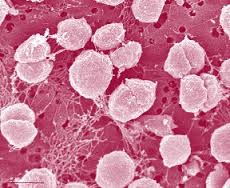Kingdom Eubacteria
1) Escherichia Coli- (E.Coli) is a part of the kingdom Monera , and is in the bacteria domain. This type of bacteria has no nucleus and can commonly be found in many warm blooded animal’s intestines.
2) Salmonella- Also apart of the kingdom Monera, and in the bacteria domain, salmonella is a bacteria that can cause infections. It is again a bacteria that does not need a nucleus.
Kingdom Protista
1) Trypanosoma brucei- is found in the kingdom Protista and in the Eukarya domain. Also known as sleeping sickness in humans.
2) Plasmodium gallinaceum- a unicellular organism that is a part of the kingdom Protista. It is found in the Eukarya domain as it can cause malaria.
Kingdom Archaebacteria
1) Halophile- this is an organism that can live in high salt concentrations. It fits into the kingdom Archaebacteria and is a part of the archaea domain as it can live in an extreme environment.
2) Euryarchaeota- is a part of the kingdom Archaebacteria and is also in the archaea domain. This bacteria produces methane with are usually found in intestines.
Kingdom Fungi
1) Ascomycota- Mostly known as “sac fungi”, this fungus belongs to the kingdom Fungi and is in the Eukarya domain. It belongs to these as it acts as a decomposer.
2) Ramaria- is an organism that is commonly known as some type of sea coral, but are still apart of the kingdom Fungi, and the Eukarya domain. (Although it is a lower classification)
Kingdom Plantae
1) Moss- is a part of the kindom Plantae and is a part of the domain Eukarya. This plant thrives in damp and cold areas and doesn’t produce flowers. It can be found in these areas as it goes through the process of photosynthesis.
2) Angiospermae- also known as flowering plants. This is just one of many of a huge species of them. It’s mode of nutrition is autotroph, as it can form carbon dioxide. They are found in the kingdom plantae and are a part of the domain Eukarya.
Kingdom Animalia
1) Reptilia- all of these organisms (reptiles) can be found in the kingdom Animalia and in the domain Eukaryotic. They are all unicellular organisms.
3) Vertebrates- these organisms make up a big part of the kingdom Animalia and the domain Eukaryotic. It ranges from orcas, to bears, to humans. These are also all unicellular organisms.











